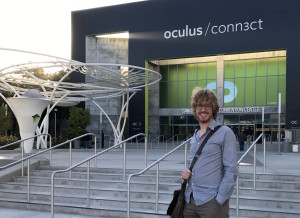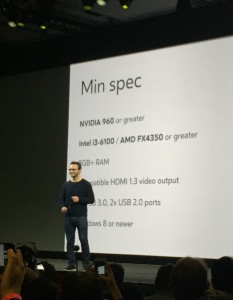Today, Oculus has unveiled its plans for virtual reality (VR) at Oculus Connect in San Jose, California.
As I’m attending the event and was in the keynote yesterday morning, I wanted to share some of things covered in the presentation that I feel are worth being excited about.
1. Room scale VR
The new Oculus Touch controllers will come with one extra motion tracker. This allows for accurate hand tracking. However, when buying a third tracker on top of that, room scale VR would be possible, allowing your position to be tracked while moving around. This could bring the Oculus Rift to the same level as its competitor HTC Vive, which had this feature from the start.
2. Social VR
Since Oculus is part of Facebook, people have definitely been anticipating Oculus and Facebook to take some steps towards social interaction in VR. Mark Zuckerberg demoed a few of the features, giving a glimpse of how multiple users could interact in VR while not having to be present at the same physical location.
Facebook CEO Mark Zuckerberg demonstrating some of the Social VR features Oculus and Facebook have been working on.
3. Stand-alone VR
Oculus is working on a ‘stand alone’ device for VR – so not a phone based solution, nor a desktop based solution, but a wearable computer and head mounted display in the same device, much like Microsoft’s Hololens.
This will allow playing VR games without having to be tethered to a PC, without occupying your phone. This hardware can potentially be more optimized for its task as compared to a phone, resulting in improved performance.
4. Reduced hardware cost through software optimization
In order to reduce motion sickness in VR, a constant rate of 90 frames per second is desired. However, this requires a state-of-the-art desktop computer. To allow using VR comfortably on cheaper computers, Oculus is working on algorithms to automatically generate additional frames in case the frame rate would go below 90.
This will allow a cheaper price point for Oculus Ready PCs, as low as $500, where the current cheapest solution is $750.
Conclusion
It’s good to see how Oculus is catching up with its biggest competitor – the HTC Vive, and how it sees VR as a medium which it tries to push forward by copying over some of the existing innovations and adding its own improvements. This should result in a better ecosystem of hardware on top of which VR developers can create great applications.
The last year, there’s been a rise in the amount of VR developers, with a lot of startups entering the competition. Therefore, we expect to see an increase in the need for rapid prototyping. Meanwhile, we’ve been working on VR projects quite extensively at PreviewLabs during the last two years, using Oculus Rift as well as HTC Vive. This work includes prototyping work for games to be used for rehabilitation of fine motor skills, as covered earlier on our blog.


